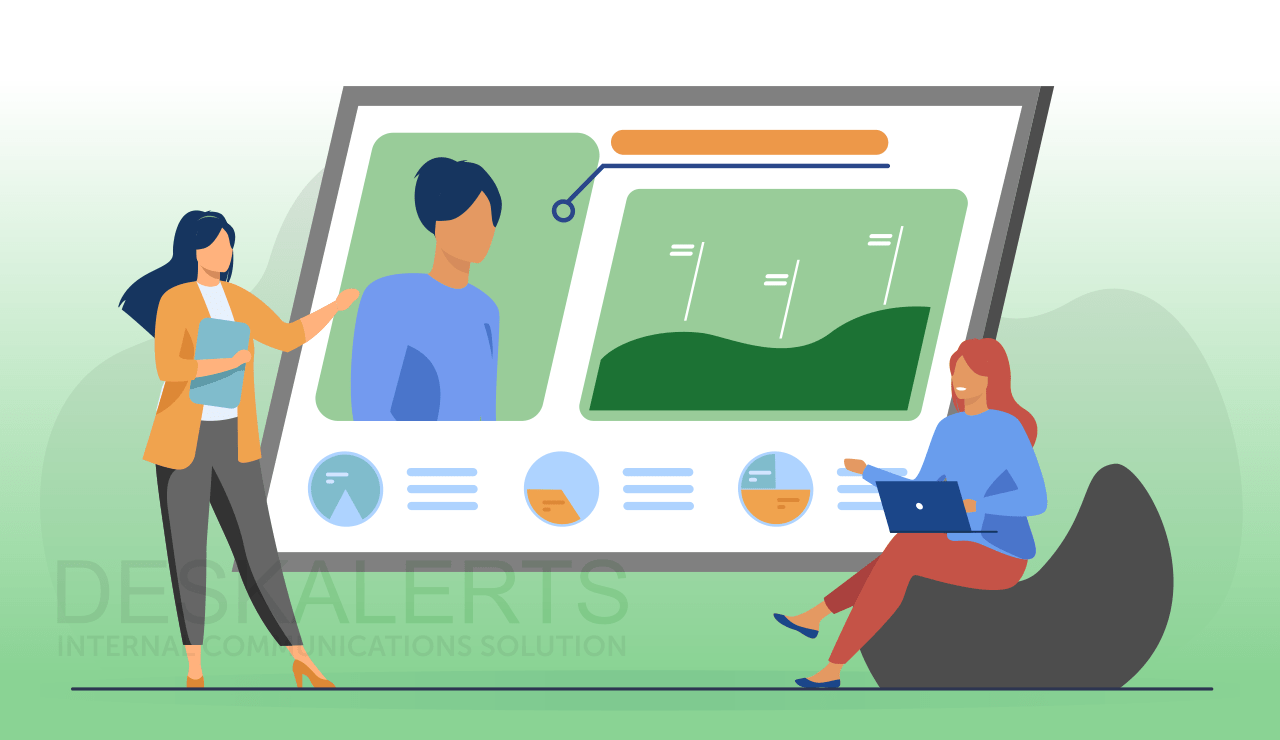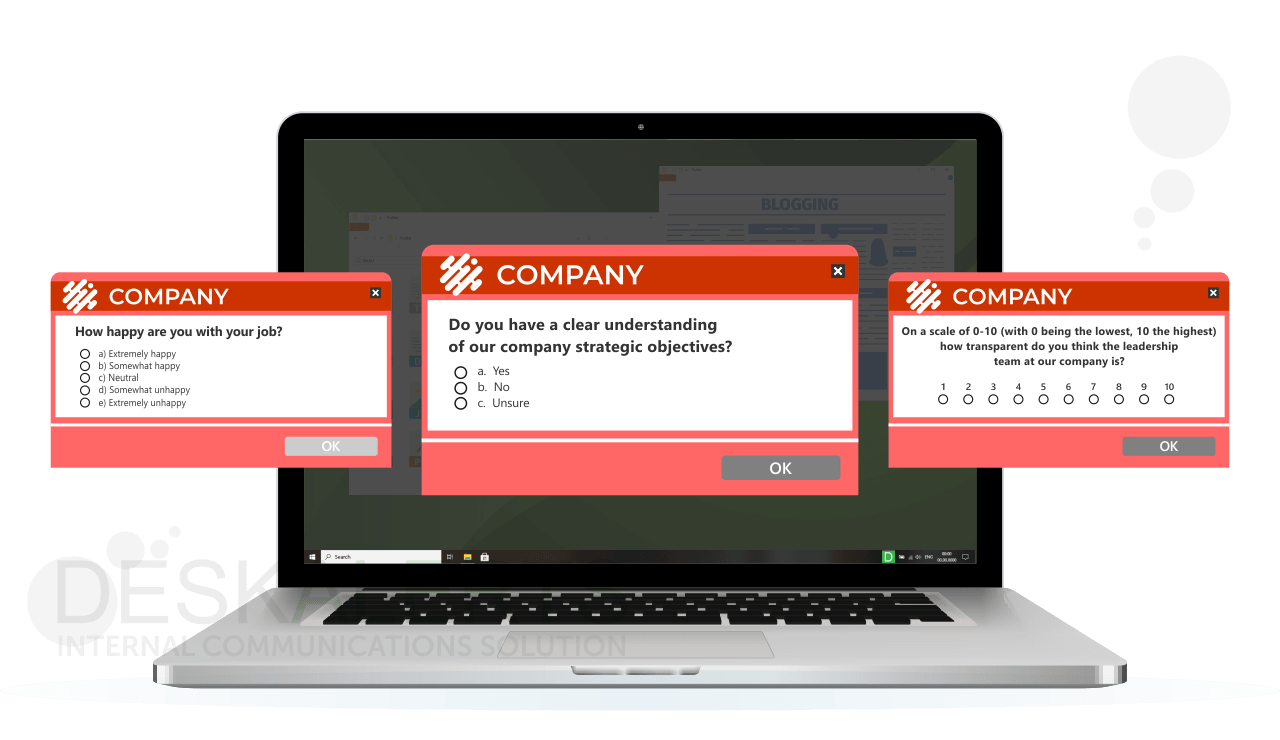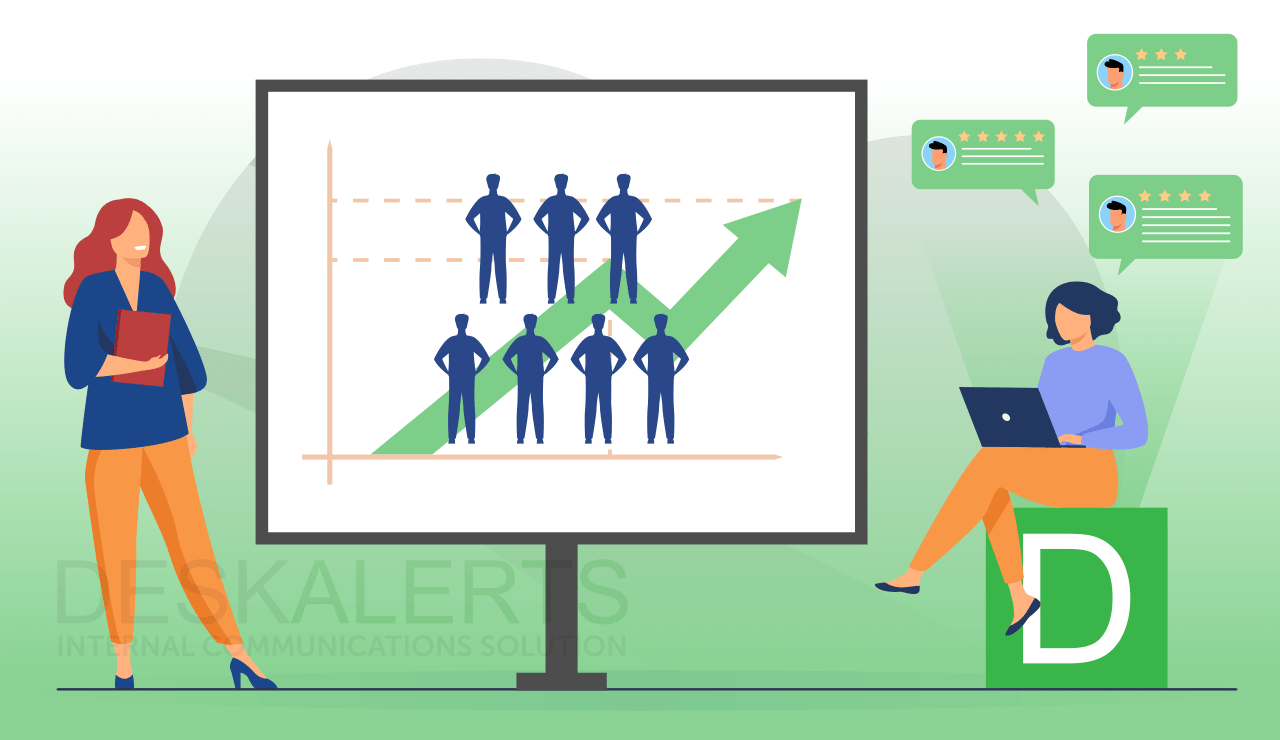
Measuring employee experience can help you to understand if you are delivering on what employees want, and whether or not your employees are happy or likely to start looking for a new job. It’s important to understand your employee experience metrics to make appropriate improvements and protect your company’s bottom line.
Table of contents
What is employee experience?
Why is employee experience important?
Employee experience metrics
Steps to measure employee experience
How to improve employee satisfaction
How to measure and improve employee experience with DeskAlerts
What is employee experience?
Employee experience is the way that an employee experiences all aspects of their workplace: this includes the workplace culture, the physical working environment and the technology and tools that they have to work with. Different companies may include other factors in their employee experience definition.
Why is employee experience important?
Providing a positive employee experience to your staff is important for a number of reasons that are all linked to improving productivity and reducing other overheads – all of which contribute to a business's bottom line.
This includes:
- Attracting and retaining the best candidates in your field and therefore reducing recruitment costs while also having skilled talent that gives you an advantage over your competitors
- Strong teamwork and collaboration, which leads to improvements in productivity
- Improved employee engagement, which means you’ll often have team members willing to go above and beyond to help the company succeed
- Boosted creativity which leads to innovation
- Improved mental health and wellbeing, which means lower absences
- Benefits to corporate reputation
- Employees who are given the opportunity to grow, develop and take on more responsibility within the company.
Employee experience metrics
There are several different metrics that you can use to determine the employee experience in your organization. These are based on how employees experience different stages of their employment life-cycles with your company.
Aspects of the life-cycle to measure include:
1. The recruitment experience
First impressions definitely count, and the experience someone has at the very beginning of their relationship with your company as a potential employee can help to set the tone for their ongoing experience. The experience someone has as a candidate includes how they were treated during the hiring process. Was it a positive experience? Was it arduous? Was it warm and engaging or was it cold and impolite? Was it confusing in any way?
2. The onboarding process
How you treat a new hire in their first days and weeks with the company can help define how they feel about ongoing working there. If the experience is haphazard, confused and hostile, they are likely to start looking for another role.
3. Learning and development opportunities
Employees want to grow and develop, which means you need to provide them with training for their current roles and up-skilling them so that they are prepared for future opportunities.
4. Performance management
The process that you use to evaluate performance should be tied to the employees’ own development goals as well as the company’s overall goals. Feedback and coaching should form part of this, and it should be a valuable experience for the employee.
5. Health and wellbeing
Offering health and wellbeing programs to employees shows that you not only care about them, but you are encouraging them to prioritize their health and wellbeing so that they can be happy and healthy.
6. Workplace culture
Fostering a workplace culture that is respectful, caring, collaborative and harmonious will help enormously with employee experience and is one of the most important factors in retaining employees. People don’t want to show up to a stressful, toxic workplace every day where they are disrespected and harassed.
7. Tools and technology
When people feel they have the right tools to do their jobs, they are less likely to be stressed or feel negatively about their company. Not having fit-for-purpose tools and outdated or underperforming technology can lead to frustration and resentment.
Steps to measure employee experience
 There are two main ways to measure employee experience in your company: these include quantitative and qualitative data analysis.
There are two main ways to measure employee experience in your company: these include quantitative and qualitative data analysis.
You can use quantitative and qualitative data from different stages of the employee life-cycle mentioned above to get an overall, holistic picture of what the employee experience is like in your company, gathered from different sources.
Quantitative methods of measuring employee experience include:
- sending surveys about specific topics such as how someone found their onboarding experience
- more comprehensive employee engagement surveys
- pulse surveys
- looking at internal data such as employee turnover rates, absences and how many employees apply for internal promotions
- calculating an employee value proposition
- calculating your employee engagement ROI
- analyzing employee efficiency metrics.
Qualitative employee experience metrics include:
When analyzing your data, you should also break it down and group it into different demographics to get the most accurate picture of your workplace experience possible, as it may vary widely depending on specific demographic cohorts.
You should look at things like the location employees work in, their role, their team and other factors like age and gender. For example, Millennial employees may have a positive experience working for your company while older generations may not find it suits them so well. Or you may have a great workplace culture everywhere except for one particular office where management is problematic and makes everyone miserable. All of these steps are also useful if you want to know how to measure employee engagement metrics.
How to improve employee satisfaction
There are many different ways to improve employee satisfaction. Some of them are tied to remuneration and benefits, while others are about creating a workplace that people want to attend and be part of.
This includes:
- Offering employees a competitive salary - don’t let this be a reason they leave and go to work for your competitors!
- Listen to employees and ask for suggestions to make improvements in the workplace – they understand what it is right on the front line more than management does.
- Be transparent – when you ask for feedback or survey your employees, they will want to see what you do with that information.
- Provide benefits that employees would want, such as health care, access to gyms and other wellbeing measures. Make them family-friendly and include things like subsidized childcare or elder care.
- Provide genuine flexibility in the workplace.
- Take workplace health and safety seriously and act quickly to fix any hazards or other issues identified by employees.
- Take time to celebrate successes in the workplace
- Reward and recognize top performing employees.
- Provide continuous learning and development opportunities
- Provide employees with other development opportunities such as mentorships.
How to measure and improve employee experience with DeskAlerts
DeskAlerts can assist you in both measuring and improving the employee experience within your organization. This software system is specifically designed to improve and measure employee communication and engagement within large organizations.
Using the DeskAlerts survey tool, you can create pop-up surveys sent directly to employees’ PCs or mobile devices asking questions on whatever topic you like. There is no limit to how many surveys you can send, or how long they can be.
The surveys can be sent to appear discretely on screens or to be large and take up the entire screen – it is completely up to you how you would like to send them. You can create surveys on any topics you would like to measure, including employee experience metrics. Data can then be analyzed so that appropriate improvements can be made.
We have created a free employee experience survey that you can download and use so that you can get started!

As well as employee experience surveys, other ways DeskAlerts can help improve the employee experience in your organization include:
- Improving communications
- Improving levels of engagement
- Sharing and celebrating successes and recognizing achievements through creative screensavers or digital signage
- Boosting the number of participants at corporate events through RSVP pop-ups
- Reaching and connecting the workforce no matter where they are working, including remote employees or non-desk workers
- Sending tailored, targeted information to specific audience groups within your company.
***
The employee experience is extremely important for companies to be aware of and pay attention to in 2022. The COVID-19 pandemic has changed the way many people view work – and they want to be happy and content in their workplace. Otherwise, they might resign.
Get in touch with us today for a free demonstration to find out how DeskAlerts can help improve and measure the employee experience in your company.
Frequently asked questions
What is employee experience?
Employee experience is the experience that workers have throughout their life cycle within an organization, including their workplace, their health and wellbeing, the tools and equipment they use, their career progression and other key touchpoints.
What are the elements of employee experience?
The key elements of employee experience include:
- A set of perceptions from employees at different periods of time, and at different touchpoints in their life cycle in the organization
- Different types of environmental factors such as the physical workplace, the culture of the organization and the technology it uses
- Human resource functions that recognize employee engagement as a KPI and the benefits it brings to the organization.
What is the Employee Experience Index?
The Employee Experience Index is a ranking and scoring of 252 companies from across the globe based upon seventeen different employee experience factors. These include variables that employees value most at work, including workplace culture, physical workspace and technology.
Why is employee experience important?
Employee experience is important to help you retain your best employees. It also has a flow-on effect that improves many different metrics within the company, all of which positively impact productivity and the company’s bottom line.
 Caroline Duncan
Caroline Duncan

 There are two main ways to measure employee experience in your company: these include quantitative and qualitative data analysis.
There are two main ways to measure employee experience in your company: these include quantitative and qualitative data analysis.






